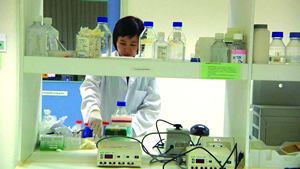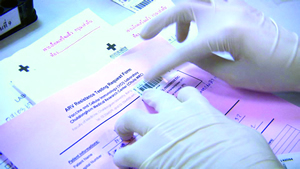Testing the HIV Genome: A Key to Long-term Treatment Success
TREAT Asia Quality Assurance Program

Dr. Sunee Sirivichayakul in the lab at Chulalongkorn University in Bangkok, which participates in TAQAS. (Photo: Louis Galdieri)
|
October 2010 —Nothing about HIV/AIDS is simple, but few aspects of its treatment are as complex as the genetic analysis required to determine if HIV has become drug resistant. Because resistance to lifesaving antiretrovirals has a critical influence on the long-term success of treatment scale-up in Asia, HIV genotyping is an increasingly important tool.
For the last five years, TREAT Asia has been working closely with laboratories across the region through the TREAT Asia Quality Assurance Scheme (TAQAS), the goal of which has been to ensure the accuracy and consistency of HIV genotyping.
The process of HIV genotyping involves analyzing the genetic material of HIV to see if mutations in the viral genome have made it resistant to drugs. "HIV genotyping allows for more accurate selection of the antiretroviral drugs that are most likely to lead to treatment success in patients who have failed their first regimens," said TREAT Asia Director Annette Sohn, M.D. "It is especially helpful in children who will need careful regimen sequencing through adulthood."
'Home-brew' testing
While commercial test kits simplify the process of HIV genotyping, most hospitals in Asia cannot afford them. As a result, many labs develop their own in-house or 'home brew' assays, which require less expensive reagents and equipment than the commercial alternatives. Although all tests are susceptible to technical and human error, hospitals using in-house assays frequently lack the technical support to help troubleshoot problems with testing. TAQAS seeks to create access to this type of technical support while setting standards for HIV genotyping that can improve the quality of patient care.
Under the TAQAS program, Sally Land of the National Serology Reference Lab in Melbourne, Australia, has sent panels of five plasma samples to 20 participating labs (including three from Africa). The labs return their results to Melbourne for analysis and review.
"Labs that have a lot of molecular experience do very well," said Land. "For labs that are setting up the protocol, it can be quite difficult to optimize their testing. TAQAS shows them where they are falling down and in what areas they need to concentrate and improve.
"A number of laboratories may have a problem detecting all drug resistance mutations when they first test a panel—that is, they will detect maybe 60 to 70 percent of the drug mutations in all the samples," she continued. "What we've seen again and again is that as they test subsequent panels, their results significantly improve. Labs participating regularly in the program frequently detect more than 95 percent of mutations."

Drug resistance testing forms at Chulalongkorn University in Bangkok. (Photo: Louis Galdieri) |
TAQAS was launched in 2006 as part of a major initiative funded by the Dutch government to help build capacity for HIV drug resistance surveillance and monitoring in Asia and Africa. Next year, this funding will end, but TAQAS participating labs have generated a meaningful long-term gain for AIDS care. These labs, which are increasingly able to meet international standards, are now being transitioned into a parallel program being offered by Melbourne's National Reference Lab— graduating from a regional to a global program.
But HIV drug resistance remains of secondary concern to many funders, whose increasingly limited funds tend to support programs that address the front end of the epidemic, such as HIV testing and getting infected people into treatment. Regional clinicians recognize that the problem of drug resistance will arise more often as patients spend more time on treatment. Without greater investment in the components of care that prevent the emergence of drug resistance and treatment failure, patients will be faced with fewer options to sustain the benefits that antiretroviral therapy initially offered them.